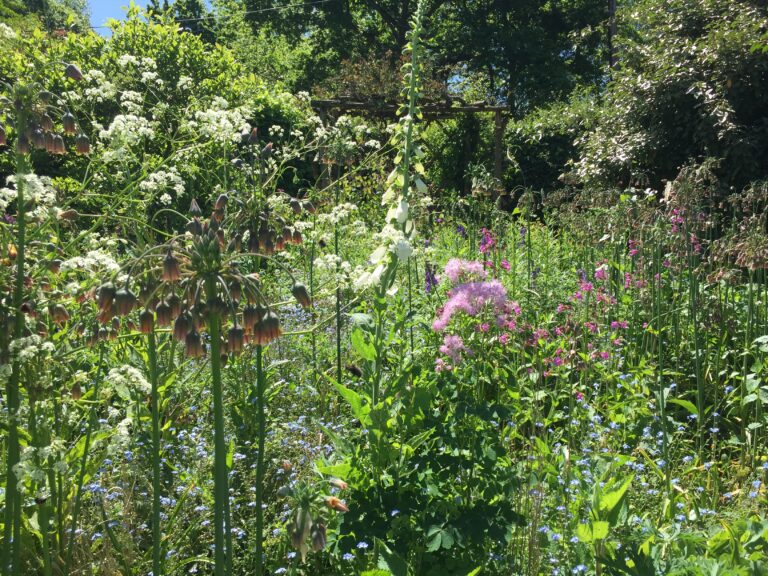By mid-May the spring surge of growth has not yet tipped into summer.
Everywhere is now leafy but still tissue thin and some trees are still letting the light through to the ground. The spring flowers and blossom are finishing but this is an in-between stage while the air is still damp and nights are cool. It is easy to overlook this time without a name, so Chelsea week is a convenient prompt to stop and look and fill some gaps for now and for later.
What is the “Chelsea chop ?
We can give the insects a continuous supply of nectar and pollen simply by delaying the start of flowering of half our plants. Cut back at least a third of each stem to a healthy leaf joint on some of the stems on each plant. So some stems flower at the normal time and the tipped ones carry on for 3 or 4 weeks longer into late summer and autumn. The added benefit is that herbaceous flowers are less likely to flop over in the wind eg Michaelmas Daisies and Sedum spectabile / Hylotelephium.
We can also stagger the flowering of Lavenders, Buddleia and Roses by dividing their spring pruning between 2 different times. As our unpruned Roses began early I am picking big bunches of them now in May in order to have their 2nd flowering earlier, perhaps in July. Cut back to a large leaf or an old leaf joint. Bendy stems will produce more buds if you tie them down like hoops. Any Rose with visible stamens attracts a bee.
Even a mini garden meadow benefits from cutting part of it at the end of May so that it will re-grow and continue flowering when the rest has finished. However leave uncut single stem flowers such as an Orchid or an Allium or Yellow Rattle and the green leaves of spring bulbs. The added benefit is that it weakens the grasses and doesn’t aggravate hay fever.
What was flowering for pollinators at Chelsea ?
Foxgloves, Opium Poppies, Columbines /Aquilegia, Cranesbills/Geranium, Alliums, Angelica, Honesty, Thalictrum, Geums. But perhaps we should call this Cow Parsley-time. It does smother smaller plants so dead head it or grow another less prolific umbellifer.
Pride of place was given to a perfectly grown multi-stem Hazelnut ,a home for all kinds of other insects such as Bush Crickets and Lace Wings.
Columbine and Sweet Cicely with Fringe Cups to cover the shaded ground. The soil is free draining.
Other plants for May
A large multi-stem shrub is a perfect ‘tree’ for a small garden with no risk of shading the neighbours as well. Our coppiced Hazels keep the small birds busy pecking the grubs all day where we can watch them, presumably to feed their chicks. The Buddleia is also popular for pecking by Blue tits and Sparrows, and Roses with aphids.
The fruit blossom is over but these shrubs will keep the bees coming back:
Ceanothus; and the scented Pittosporum tobira, Oleaster/ Russian Olive/ Eleagnus angustifolia and Wisteria, if you like a challenge with pruning.
Sicilian Honey Garlic, Foxgloves, Thalictrum, Campion, Forget-me-nots, Honesty, Cow Parsley. These will grow in a free draining soil and are not eaten by snails
Melene






